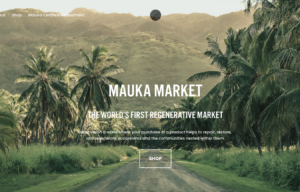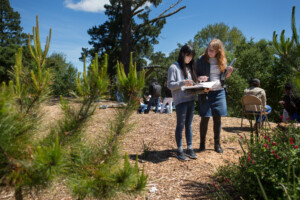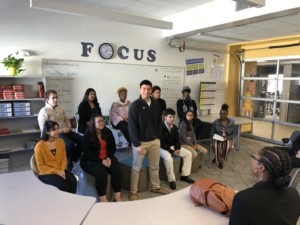The 5 Core Components of K-12 Entrepreneurship Education

Economists and others have been announcing the arrival of the “Gig Economy” (an environment where temporary or contract work is the norm) for some time now. Causes include globalization, digital technology, mobile work, labor/benefit costs and top talent demands among others. Estimates are that 40-50% of American workers will be freelancers by 2020. Think Über or Airbnb times 50. Indeed, my postal delivery person does not work for the post office but rather contracts with them to deliver the mail.
This dramatic shift in how we will work begs for a new type of employee – complete with new skills such as ideation, innovation, digital and virtual global collaboration, design thinking, transdisciplinary practices, adaptive thinking and cross-cultural competencies. More simply put, we need to be giving our students an Entrepreneurial Mindset, an umbrella that covers all of these skills naturally and effectively.
Adopt A Project-Based Pedagogy with Real-World Experiences
The most universal pedagogy to address our multitude of educational goals, including an entrepreneurial mindset, is Project-Based Learning. PBL creates, cultivates and curates an environment where students get ground-level entrepreneurial training by having to come up with product ideas, collaborate with a variety of partners, and ultimately present and publish findings to diverse public audiences. In the process of both project design and execution, we learn project management, adaptation, self-direction, risk-taking, divergent thinking and how to take feedback and critique. PBL gives all students great opportunities to develop their own ideas, innovate new products and solutions, collaborate with multiple stakeholders, apply learning across disciplines, continually reflect and adapt and learn about process as much as product. The engagement and experiential learning that take place are further amplified when students are able to tackle real-world issues that matter to them and their community. The Buck Institute and their High Quality PBL are leading the charge in this area.
Create Digital Portfolios & Cultivate Personal Branding
Students are already great digital consumers, but they need to transition into becoming talented digital content creators by showcasing and sharing their work. This is the difference between knowing new literacies and applying new literacies. For portfolios, there are dozens of free website building applications (Weebly, Wix, About.Me, Google Sites, Site 123, WordPress are just a few) where students can share their presentations, videos, photography, projects, art, music, awards and service work.
Blogging could also be another great option for students (free blogging sites such as Blogger, WordPress, Kidblog and Edublogs are a great start). Blogging gets them writing, publishing, reflecting, networking and learning to create quality digital content. Or for video, maybe it’s Vlog (video blog) where students can publish on YouTube and Vimeo – or maybe even host their own YouTube Channel.
Finally, social media is a part of the new 21st century literacies. It can be both a hands-on way of developing digital literacy and global citizenship, and a way for all of us to drive others to our work. We need to model for our students that Facebook, Twitter and Instagram are extensions of their daily portfolio and resume development.
Expand Student Roles & Responsibilities
We have been putting students in various roles for years. But it’s time to ratchet this up a lot. After all, students need things to include in their portfolios and digital profiles that articulate specific and advanced skills, while also having demonstrated high levels of responsibility, skill and dedication.
For example, what if one’s class or program had a Media Coordinator responsible for coordinating the video work? Or a Social Media Coordinator handling the class Facebook, Instagram and Twitter Accounts? How about a Project Coordinator responsible for calendars, roles, timelines and deliverables? One could keep going with a Design Coordinator, Social Coordinator, Web Coordinator, YouTube Channel Coordinator, Community Coordinator and many others. How about Peer Coaches? This is a great way to get students taking greater responsibility for the strategic needs of classrooms and their communities by allowing them to bring their expertise and experience forward for the greater good, all while also enhancing their skills, resumes and portfolios. It also can give students some real-life practice with how cross-team collaboration actually happens within businesses today.
At my former high school, we created the Student Project Coordinator. Students who were advanced in a given curricular area, or showed tremendous enthusiasm and skill, could apply for this position that had students in the role of facilitator of learning.
Master Presentation Skills
We’ve all heard the expression that “everyday is an interview.” Well, in the Gig Economy, this might be truer than ever before. Our students will be regularly expected to pitch, promote and present their professional skills and competitive advantages. In more performance-based environments, all students need to have multiple opportunities to become an expert and present their findings, conclusions and applications. There are dozens of resources, but having students get exposed to things like Nancy Duarte and Slide:ology would be appropriate. Many classes, programs and schools have started to have their students do Final Portfolio Presentations – or Defense of Learning Activities – in order to capture this deeper learning experience. My former school designed a year-end portfolio presentation students would do each year entitled the Personal Brand Equity. This culminating project not only required them to analyze and assess their learning and best work, but also do the same for them as a growing, learning and ever-improving young professionals (skills focus).
Cultivate a Design Thinking Culture
The rationale behind design thinking centers on a pedagogy aimed at creating and facilitating future innovators and breakthrough thinkers. It is about creative and collaborative workflows engineered at tackling big projects and prototyping to discover new solutions.
A great schoolwide example is from New Tech High School Napa and Principal Riley Johnson. They begin each school year with a different design thinking challenge for staff and students. According to Johnson, it is important that both students and teachers are immediately immersed into a three-day design thinking environment that sets the tone, culture and their mindsets for the upcoming school year.
Teachers guide students through specific themes that interest them most before getting in mixed grade groups. Examples include: teens, human rights, water, privacy, violence, equity, immigration, change as growth, food waste and robotics. Students, in their theme groups, go through a process of building empathy in potential users, creating a needs statement, brainstorming and ideation, generating prototypes and testing their ideas. Everyone presents and prizes are awarded.
Core of the Core
To develop the necessary entrepreneurial mindset going forward, our students need to have an in-depth understanding of the economic world that they are entering, the skills they need in order to compete, and multiple experiences to inform them on their professional paths. They need their curriculum and instruction – or rather their learning experiences and performance opportunities – to allow for ideation, innovation, new literacies, digital and virtual global collaboration, design thinking, transdisciplinary practices, adaptive thinking and cross-cultural competencies. The above strategies can be a great way to begin focusing on these skills.
For more, see:
- Learn to Earn: The Entrepreneurship Education Landscape
- Giving Students the Keys to Entrepreneurship Before They Can Drive
- Proposal for an Innovation Diploma
Stay in-the-know with all things EdTech and innovations in learning by signing up to receive the weekly Smart Update.







0 Comments
Leave a Comment
Your email address will not be published. All fields are required.